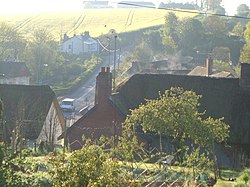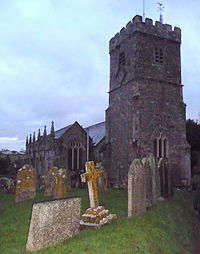Newton St Cyres
| Newton St Cyres | |
| Devon | |
|---|---|
 Newton St Cyres | |
| Location | |
| Grid reference: | SX8897 |
| Location: | 50°46’15"N, 3°35’22"W |
| Data | |
| Population: | 562 (2011) |
| Post town: | Exeter |
| Postcode: | EX5 |
| Dialling code: | 01392 |
| Local Government | |
| Council: | Mid Devon |
| Parliamentary constituency: |
Tiverton and Honiton |
Newton St Cyres is a village in Devon, in the midst of the county between Crediton and Exeter. It had a population of 562 at the 2011 Census.
The village was almost destroyed by fire in the early 1960s.[1]
There are two public houses: the Crown and Sceptre and the Beer Engine.
The village has its own railway station, Newton St Cyres, which serves the Exeter to Barnstaple line.
Parish church

The Church of St Cyr and St Julitta[2] is the parish church and the village's main point of interest. Most of the church is in early Perpendicular style, built of local reddish 'trap', a volcanic stone from quarries at Posbury, with the exception of the nave pillars, which are of Beer stone.[3] It contains the monument with standing effigy of John Northcote (1570-1632) of Hayne, lord of the manor of Newton St Cyres.
Sport, leisure and society
Traditional cheeses can be bought from the Quickes Farm shop.
The village has a recreation ground with two football pitches, a cricket pitch and two tennis courts.[4]
Historic estates
The parish of Newton St Cyres contains various historic estates including:
The location of the house was marred by the presence of the busy main-road between Crediton and Exeter,[5] which passed almost next to the house and separated it from the parish church. To ameliorate the situation, at some time before 1797, John VII Quicke employed soldiers returning from the Napoleonic Wars to lower the road by digging out a 50 foot deep cutting, over which he built a private footbridge linking his house with the church yard. Thus the house now appears sited at the edge of a cliff,[5] The house burned down in 1906, but was rebuilt in 1909. It was converted into flats and sold by the Quicke family, which in 1967 had abandoned it in favour of nearby Sherwood within the same parish.[7]
- Sherwood House,[8] built in 1918 by Adrian Cave, to the design of his cousin the architect Walter Cave[9] of Sidbury, in the Arts and Crafts style.[10] It was occupied by the Quicke family, which had abandoned nearby Newton House, from 1967 until its sale in February 2017. The business known as Quicke's Cheeses was established by John X Quicke, using milk from the 2,400 acre estate in the parish still owned by his family.
- Hayne, ancient seat of the Northcote family, in 1885 elevated to the peerage as Viscount St Cyres of Newton St Cyres and Earl of Iddesleigh. Demolished prior to 1797.[5] The Northcotes moved to Pynes in the parish of Upton Pyne, Devon.
Outside links
| ("Wikimedia Commons" has material about Newton St Cyres) |
References
- ↑ "Settlement Character Part 3". Mid Devon District Council. https://www.middevon.gov.uk/media/103551/tvc-settlement-character-part-3.pdf. Retrieved 15 July 2016.
- ↑ Nikolaus Pevsner: Pevsner Architectural Guides
- ↑ Britain Express: Newton St Cyres
- ↑ Newton St Cyres: Mid Devon DC
- ↑ 5.0 5.1 5.2 5.3 Journals of the Reverend John Swete (published in Travels in Georgian Devon: The Illustrated Journals of Reverend John Swete, 1789-1800, ed. Todd Gray & Margery Rowe, 1999) , page 126
- ↑ Vivian, Lt.Col. J.L., (Ed.) 'The Visitations of the County of Devon: Comprising the Heralds' Visitations]] of 1531, 1564 & 1620' (1895) pp.854-5)
- ↑ Lauder, p.129
- ↑ Lauder, Rosemary: 'Devon Families' (Tiverton, 2002) p.129
- ↑ Nikolaus Pevsner: The Buildings of England: Devon, 1952; 1989 Penguin Books ISBN 978-0-300-09596-8page 597
- ↑ Lauder, p.129
